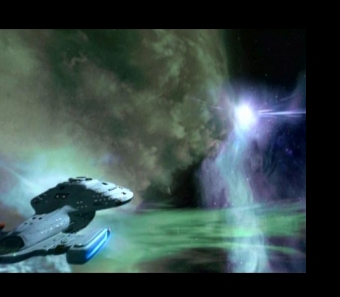|

In Star Trek, a plasma drift is a large nebula-like
interstellar phenomenon. In the Star Trek: Voyager episode "The
Haunting of Deck Twelve"), Neelix mentions that a large plasma drift
moved through his home system, blocking out the stars and moons for
months. In the episode "Deadlock", the USS Voyager entered a plasma
drift almost half a sector long, to hide from a Vidiian-controlled star
system.
Such vast clouds of plasma do in fact exist in the real
universe. Combining the world's largest radio telescope at Arecibo,
Puerto Rico with a precision imaging, seven-antenna synthesis radio
telescope at the Dominion Radio Astrophysical Observatory (DRAO), a
team of researchers led by Los Alamos scientist Philipp Kronberg in
April 2007 discovered a new giant in the form of a previously
undetected cloud of intergalactic plasma that stretches more than 8
million light years across - or about 80 times the width of our galaxy,
the Milky Way. A 2-3 megaparsec zone of diffuse, intergalactic plasma,
the object is called Region A. It is in the general neighbourhood of a
dense collection of galaxies called the Coma Cluster, which lies 300
million light years from Earth. But the cloud appears to be too distant
from the cluster to be powered by it.
The synchrotron-radiating plasma cloud is spread across
a vast region of space that may contain several black hole harboring
radio galaxies. The cloud may be evidence that black holes in galaxies
convert and transfer their enormous gravitational energy, by a yet
unknown process, into magnetic fields and cosmic rays in the vast
intergalactic regions of the Universe. The diffuse, magnetized
intergalactic zone of high energy electrons may be evidence for
galaxy-sized black holes as sources for the mysterious cosmic rays that
continuously zip though the Universe. It is still not known what kind
of mechanism could create a cloud of such enormous dimensions that does
not coincide with any single galaxy, or galaxy cluster.
In 2006, a less isolated cloud of plasma was reported
around galaxy cluster Abell 3376, with similar dimensions to Region A
Astronomers suspect that cloud is the result of gas from outside the
cluster colliding with the cluster's own gas.
|
|
